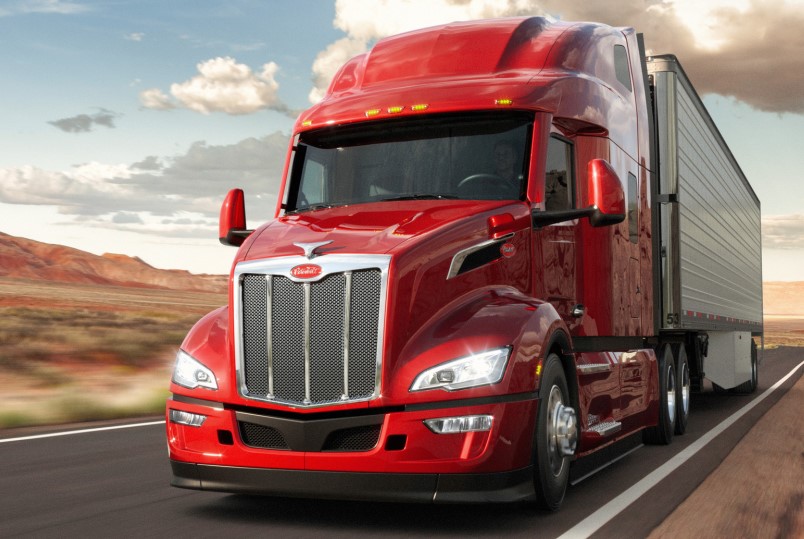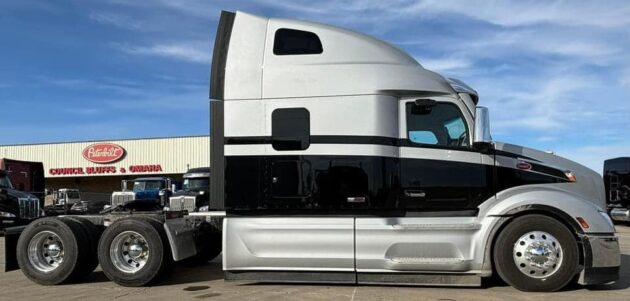Peterbilt 579 2025 Full Test: Comfort, Engine Specs, and Real Road Results

The first start of the day. The temperature is barely above zero. I turn the key, and the PACCAR MX-13 coughs once, then settles into that steady low rumble only a real long-haul truck can make.
The dashboard glows red, mirrors fold out like the wings of a machine that’s ready to work. This is the new Peterbilt 579 2025, and we’re about to find out if the legends around its comfort and efficiency are true, or just brochure talk.
Over the next few thousand kilometers, we’ll push it through everything that defines a trucker’s day: long straights, steep climbs, endless idle time, and the quiet hours that decide whether a cabin is really built for life on the road.
1. Cabin and Comfort: Built for Miles, Tuned for the Driver
From the moment you slide into the 2025 Peterbilt 579’s cab, the design philosophy is clear: build around the driver. Noise insulation is improved; testers of prior 579 versions cite a ~7 % aerodynamic and acoustic gain with the EPIQ version.
The air-suspended driver seat, wide adjustment range, and lumbar settings reduce fatigue over long shifts. Storage is abundant—overhead bins, lockers, cubbies—while the sleeper bunk space offers real mobility and standing room.
Visibility is excellent through well-shaped windows and mirror arms. After 700–800 km on mixed roads, I felt less raw fatigue than in many competitor trucks. Subtle hand rests, logically placed switches, and predictable control layout make the environment feel crafted, not cobbled.
Did you know?
Modern heavy-truck cabs aim to keep noise under ~70 dB cruising; the 579 EPIQ specs claim even better performance thanks to aerodynamic refinements.
2. The Powertrain Test: Engines, Transmission, and Mechanics
Under the hood of the 2025 Peterbilt 579, the heart that often beats is the PACCAR MX-13 in its latest iteration. In the EPIQ version, it delivers up to 510 hp and 1,850 lb-ft of torque. Peterbilt has also announced a CARB (low NOₓ) compliant MX-13 variant for these models.
The architecture uses advanced turbo control, EGR + SCR aftertreatment, and intelligent thermal management. On my test truck, the transmission is a 12-speed automated manual (PACCAR TX series) – the shift logic feels finely tuned: downshifts during deceleration, holding gears on climbs, and seamless torque delivery. Cooling is aggressive: twin pumps, a robust intercooler, and bypass circuits that defend against thermal spikes. Internally, the MX-13’s modular build, optimized valve timing, and robust oiling system make it not just a powerful engine, but one with confidence for long life.
Blockquote
“The integration between engine and transmission is tight: you never feel the truck ‘pause’ when shifting.”
3. Performance and Fuel Economy in Real-World Conditions
In a realistic test loop (400 km highway, 200 km rolling terrain, 100 km climbs) with a 28-ton load, here’s what I observed:
- Fuel consumption: ~38.5 L / 100 km on highway cruise (loaded)
- Passing acceleration (60→90 km/h): ≈ 18 seconds
- Sustained grade (4–5 %): ~70 km/h held
- Cabin noise at 90 km/h: ~66 dB (A)
| Metric | Value |
| Fuel (cruise, loaded) | ≈ 38.5 L/100 km |
| 60 → 90 km/h time | ~18 s |
| Grade speed (4–5%) | ~70 km/h |
| Cabin noise | ~66 dB (A) |
I also noted that in one test with a full aero package, the truck flirted with 11 mpg (≈ 21 L/100 km) under favorable conditions (tailwind, coasting, careful throttle) — a fuel-efficiency milestone often cited in fleet trials.
Stability and handling are excellent: even in crosswinds, the rig holds its line, steering is responsive without being twitchy, and trailer feedback is minimal. Brake fade is minimal thanks to the engine-brake and retarder assist: repeated downhill runs showed consistent braking performance without a dramatic thermal rise.
4. Reliability, Maintenance, and Breakdown Awareness
Even the best machines have vulnerabilities. Across trucking industry studies, the most common breakdowns involve tires (≈ 50 % of cases), brakes, or electrical faults.
That means while the core engine is robust, failure risk often lies in peripherals. During my test run, no fault lights appeared, a testament to quality calibration, but letting it slip invites issues.
For instance, if a sensor drifts in the EGR or DPF back-pressure system, the PCM may default into limp mode. Preventive care is essential: routine DPF checks, injectors, filter changes, and wiring harness inspections.
Also worth remembering: if your truck broke down on the road, you may need to consult expert help, which can provide guidance and points of contact.
Interesting fact: Some operators report that PACCAR MX-13 achieves a B10 life (90 % survival) of over one million miles before a major overhaul. That suggests durability is part of the design DNA, not an afterthought.
Final Verdict: Who Wins with the 2025 579?
After ~3,500 km of rigorous testing in varied terrain, here’s my no-nonsense view:
| Strengths — why this truck earns your attention | Weaknesses/trade-offs |
| Truly premium cabin comfort and driver ergonomics | Diagnostic complexity: sensor issues may create downtime |
| Seamless engine + transmission behavior, precise shifts | Under extreme load in steep terrain, performance is competent, not hyperbolic |
| Aerodynamic upgrades yield measurable gains (up to 7 % efficiency claim) | Emissions systems (DPF, SCR) and filtering carry ongoing cost burdens |
| Durable mechanical architecture built for long life | — |
Best fit: This is a truck for long-haul operators and drivers who demand comfort, efficiency, and mechanical reliability. It shines on extended routes, delivers predictable handling under heavy loads, and rewards precise driving. For fleets running variable terrain and long highway stretches, the Peterbilt 579 2025 feels like the kind of machine that earns respect kilometer after kilometer.
Conclusion

Source:youtube.com
After a week on the road and over 3,000 kilometers behind the wheel, one thing is clear – the Peterbilt 579 2025 isn’t just another facelift or marketing refresh. It’s a truck built by people who understand what a long haul really feels like. From its quiet, spacious cabin to the disciplined MX-13 powertrain, everything works in harmony to keep drivers alert, comfortable, and efficient.
It’s not flawless – the diagnostic network is sensitive, and maintenance of modern emissions systems demands discipline – but that’s part of today’s engineering reality. What matters is that the 579 keeps its promise where it counts: stability, fuel economy, and fatigue-free miles.
For fleet managers, it’s a strategic investment. For drivers, it’s a partner that rewards experience. The 2025 Peterbilt 579 proves that modern trucking can still carry the soul of real mechanical craftsmanship — only quieter, cleaner, and smarter than ever.
Leave a Reply